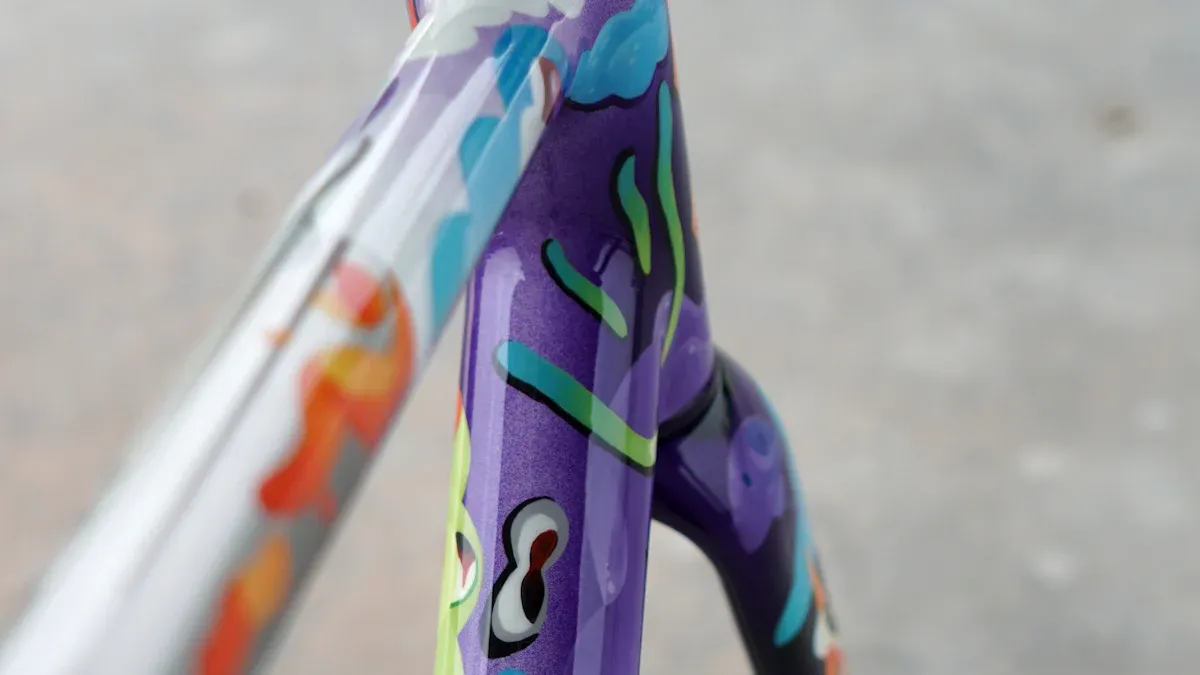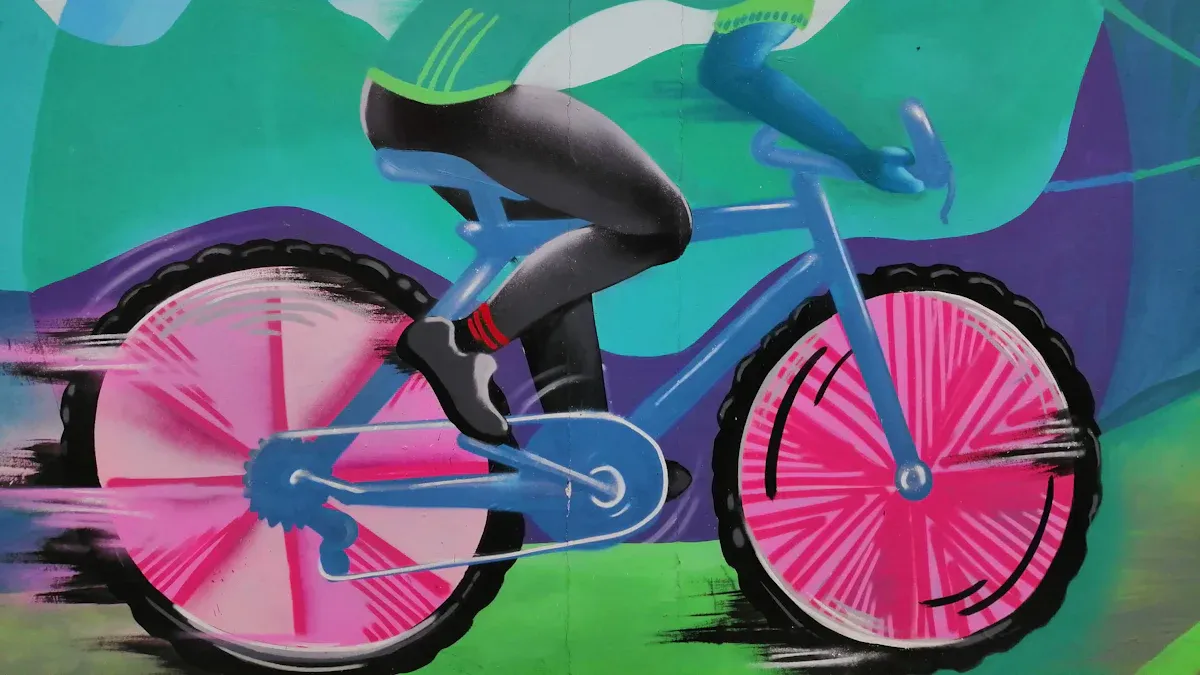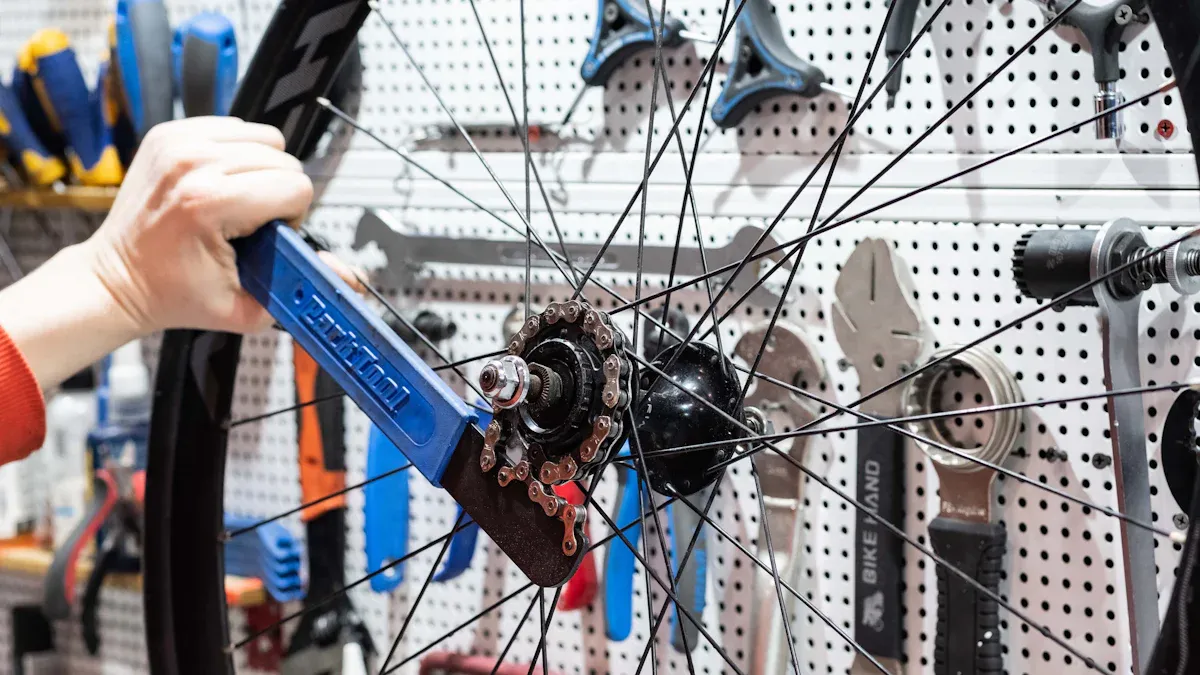
Customizing your bike frame can be very exciting, especially when you decide to paint your mountain bike frame. It helps you show your personality and make your bike special. Many bike riders choose to paint their frames for different reasons. Some want to refresh a faded finish, while others desire a unique look to stand out. Painting your mountain bike frame also protects against rust, which can help your bike last longer. However, before you start painting, it’s important to consider the pros and cons. This will help you determine if painting is the best choice for you.
Key Takeaways
Painting your bike frame lets you show your style. You can pick colors and designs that make your bike special.
A good paint job can raise your bike’s resale value. Popular colors and nice finishes attract buyers and make your bike more wanted.
Use the right paint to protect your bike from rust. Options like powder coating create a strong shield against water and damage.
Think about the costs and time needed for painting. DIY projects can save money but may take a lot of time and work.
Repainting an old bike can reduce its value. Collectors usually like original finishes, so be careful before changing anything.
PROS OF PAINTING

Aesthetic Customization
One big benefit of painting your bike frame is how you can customize it. You can pick colors and designs that show who you are. Whether you like a smooth matte look or a bright, fun pattern, there are many choices. Custom paint jobs help you stand out on trails or streets. You can also follow the latest trends, like bright colors or cool patterns, to make your bike unique.
Here are some popular color and design trends for custom-painted bike frames:
Color/Design Trend | Description |
|---|---|
Maximum visibility | Custom bike painting made for high visibility, with a matching helmet. |
Bright colors | Used in a company bike-painting challenge to bring designs to life. |
Amplified alchemy colorway | Features blues and purples, showing a bright color scheme. |
Ultra-iridescent color scheme | Made famous by Mads Pedersen in the 2023 Tour de France, looking like an oil slick design. |
Black and white with fluorescent pink | A unique mix with small pops of color for a Specialized S-Works Crux. |
Neon, glitter flakes, splatter, foil prints | Different artistic styles that show creativity in custom designs. |
Color gradients, clean or freaky patterns | Shows the variety and challenges in custom bike painting, highlighting personal expression. |
Increased Resale Value
Another good thing about painting your bike frame is that it can raise its resale value. A nice custom paint job can make your bike look better. Buyers often want bikes that are different, and a good paint job can attract them. But remember, a bad job or a strange design might turn buyers away.
Here are some factors that can influence resale value:
A good paint job can raise resale value.
Popular colors like matte black or graphite silver usually sell better.
Special edition colors can become collector’s items, raising resale value.
Protection from Rust
Painting your bike frame also helps protect it from rust. The right paint works as a shield against moisture and other elements. For example, powder coating is strong and thick, which helps stop corrosion. Studies show that coatings like ED (electrodeposition) can last over 1000 hours in salt spray tests, showing strong rust resistance. This means that even if the top layer gets damaged, the layers underneath still protect against rust and oxidation.
Personal Expression
Custom paint jobs let you show your individuality. You can create a visual signature that matches your style. Many cyclists say their custom paint jobs express who they are on the trails. This personal touch can make your riding experience more fun and meaningful.
Improved Visibility
Finally, painting your bike frame in bright colors can help you be seen better on the road. Studies show that brightly painted bikes are easier to spot, especially in low light. For example, a bike with white stripes on a red frame can be seen from up to 138.67 meters in sunlight. This better visibility can make you safer while riding, which is smart for city cyclists.
Color Combination | Detection Distance (m) | Lighting Condition |
|---|---|---|
White stripes on red | 138.67 | Sunlight |
White stripes on red | 94.67 | Twilight without car headlights |
White stripes on red | 94.00 | Twilight with car headlights |
White stripes on red | 53.67 | Night with car headlights |
CONS OF PAINTING
Cost of Materials
When you think about painting your bike frame, the costs can add up fast. If you decide to do it yourself, you might spend between $100 and $200 on supplies. This includes paint, primer, and tools. But if you hire a professional, expect to pay much more—anywhere from $500 to over $1000. Here’s a quick comparison:
Service Type | Cost Range |
|---|---|
DIY Bike Frame Paint | $100 – $200 |
Professional Service | $500 – $1000+ |
You should also think about the type of paint you want. Better quality paints and finishes can cost more. For example, a standard high-quality paint job can range from $1400 to $1600, while custom jobs can go up to $2200 or more.
Service Level | Price Range | Features |
|---|---|---|
Level 1 | $1400 – $1600 | Standard high quality 40-step finishing process, one main color, minor filling, decals. |
Level 2 | $1600 – $2000 | Includes Level 1 features, additional prep, painted colors, specialty finishes. |
Level 3 | $2000+ | Includes Level 1 & 2 features, advanced masking, custom artwork, additional components. |
Time-Consuming Process
Painting your bike frame isn’t just about the cost; it also takes a lot of time. You might spend over 20 hours just getting the surface ready. This includes removing old paint and preparing everything. After putting on primer, you’ll need to wait at least 24 hours before adding paint. If you plan to use multiple coats, which is often needed, you’ll have to wait another 24 hours for each coat to dry.
Here’s a breakdown of the time commitment:
Preparation can take over 20 hours.
After primer, wait at least 24 hours before painting.
Multiple coats may require additional drying time.
In total, DIY painting can take 45 to 90 hours of work. In contrast, professionals can finish similar tasks in just 3 to 5 days, saving you a lot of time.
Risk of Poor Finish
One of the biggest risks of painting your bike frame yourself is getting a poor finish. Many things can lead to this, such as:
Using low-quality paint
Not waiting long enough between coats
Not allowing enough time for the paint to cure fully
Without the right skills or tools, you might end up with a finish that looks uneven or unattractive. Getting a professional-quality finish is hard without experience. Brushing may seem easier, but it often doesn’t give great results. Spraying needs careful technique to avoid overspray, which can be messy.
Maintenance Challenges
Taking care of a painted bike frame can be hard. Painted frames are more likely to rust and corrode, especially if the paint chips or wears away. Unlike chrome plating, which resists corrosion, painted surfaces need regular touch-ups. You might find yourself needing to repaint or touch up scratches often. Here are some common maintenance challenges:
Painted frames are more susceptible to rust.
Chrome plating offers better corrosion resistance.
Impact on Vintage Value
If you own a vintage bike, painting it can lower its value a lot. Collectors usually prefer original finishes. Repainting can lead to a drop in value of 10% to 20% or more, depending on how desirable the bike is. For example, a Cyclart respray of a Confente sold for $7,600, while an original paint example sold for close to $11,000. This shows how repainting can affect market value.
PAINT MOUNTAIN BIKE FRAME
Choosing the Right Paint
When you decide to paint your mountain bike frame, choosing the right paint is crucial. You want something that not only looks good but also stands up to the challenges of outdoor riding. Here are some top options to consider:
Powder Coating: This type of paint is known for its durability. It has an epoxy base, making it perfect for harsh conditions. While it may not be the most visually appealing option, its longevity is a significant advantage.
Ceramic Coatings: These coatings are excellent for protecting your bike from the elements. They repel mud and dirt, making it easier to clean your bike after a ride. Plus, they offer great UV protection, which helps prevent paint fading.
Cerakote: This ceramic-based coating is a favorite among mountain bikers. It resists chipping and blistering, common issues with traditional paint finishes. Cerakote also withstands chemicals like road oil and brake fluid, ensuring your bike looks great for longer.
Professional vs. DIY Options
Now that you know about the different types of paint, let’s talk about whether you should go professional or tackle the project yourself.
Professional Painting: If you want a flawless finish, hiring a professional might be the way to go. The average cost for professional painting ranges from $350 to $750, with most jobs costing around $516. Professionals have the skills and tools to ensure your bike looks amazing and lasts longer.
DIY Painting: If you’re on a budget, you might consider painting your bike frame yourself. DIY painting can cost as little as $70. However, keep in mind that you’ll need to invest time and effort into the process. You might spend hours preparing the frame, applying paint, and waiting for it to dry.
Here’s a quick comparison of the costs:
Option | Cost Range |
|---|---|
Professional | $350 – $750 |
DIY | $70 |
In the end, the choice between professional and DIY painting depends on your budget and how much time you’re willing to invest. If you want a durable and high-quality finish, professional painting is worth considering. But if you enjoy hands-on projects and want to save money, DIY painting can be a fun challenge.
HOW TO PAINT YOUR BIKE

Painting your bike can be a fun project. But it needs careful planning and skill to get a great result. Here’s a simple guide to help you.
Preparation Steps
Before painting, you must prepare your bike frame well. Follow these steps for the best results:
Dismantle Your Bike: Take off all parts to reach every part of the frame.
Clean the Frame: Use an alcohol cleaner or solvent after degreasing. This step is very important because chemical degreasers can leave a film that makes paint stick less. Be sure to remove all dust and dirt.
Sand the Surface: Sanding helps get rid of bumps and makes a smooth surface for the paint. Use 120-240 grit for steel, 240-320 for aluminum, and 320 for carbon.
Apply Primer: A good primer helps paint stick better and gives a solid base for your color coats.
Protect Areas: Use tape to cover parts that should not be painted. This ensures a clean finish.
Application Techniques
Now that your bike is ready, it’s time to paint. Here are some good techniques for spray painting:
Use Thin Coats: Apply several thin coats instead of one thick coat. This stops sagging and gives an even finish. Allow enough drying time between each coat—at least 24 hours is best.
Choose Quality Paint: Buy high-quality spray paint. A good nozzle can really help with application.
Clear Coat: Apply a clear coat before the color dries completely to create a chemical bond. This step adds strength and protects your paint job.
Smooth Out Imperfections: If the paint feels fuzzy, use parchment paper to gently smooth it out.
Remember to work in a well-ventilated area and wear protective gear like gloves and a mask. Using low VOC paints can help the environment and keep you safe.
By following these steps, you can paint your bike well and enjoy a fresh, personalized look!
Painting your bike frame can be a fun way to show who you are, but it has some challenges. Here’s a quick summary of what to think about:
Preparation: Cover areas that should not get paint and sand the frame to help the paint stick better.
Choice of Materials: Picking the right tools and supplies is important for a strong finish.
Painting Process: Make sure to apply even coats and let each layer dry fully to prevent sagging.
In the end, think about the pros and cons based on what you like and your budget. If you want a special look and are ready to put in the work, painting could be a good choice. But if you’re concerned about how long it will last or its resale value, think about other options like upgrading parts instead. Enjoy your ride! 🚴♂️
FAQ
What are the main benefits of painting my bike frame?
Painting your bike frame lets you customize its look, protects it from rust, and makes it easier to see. It can also increase resale value if done well, helping your bike stand out.
How long does the painting process take?
If you paint your bike frame yourself, it may take 45 to 90 hours for preparation and painting. Professionals can usually finish the job in 3 to 5 days.
Will painting my bike frame affect its durability?
Yes, using the right paint can make your bike more durable. Options like powder coating and ceramic coatings offer strong protection against damage, helping your bike last longer.
Can I repaint a vintage bike without losing value?
Repainting a vintage bike can lower its value a lot. Collectors usually want original finishes, so think about this before changing your bike’s paint.
Is it cheaper to paint my bike or upgrade parts?
Painting your bike frame can cost less than upgrading parts, especially if you do it yourself. However, consider the costs compared to resale value and durability before making a choice.
See Also
Essential Guidelines for Safely Painting Carbon Bike Frames
Advantages and Disadvantages of Aluminum Frame Longevity
Easy Methods to Safeguard Your Bicycle Frame
Proven Techniques to Eliminate Rust from Bike Frames
The Trials and Triumphs of Constructing a Wooden Bicycle Frame
